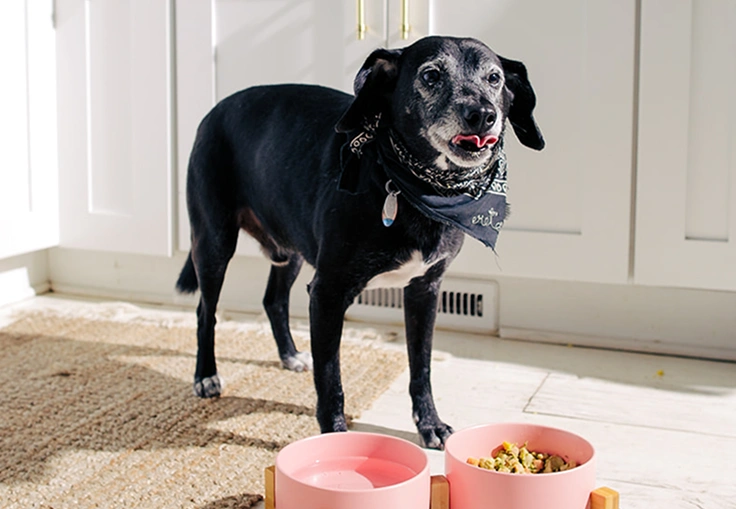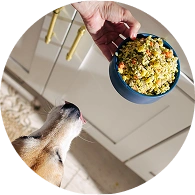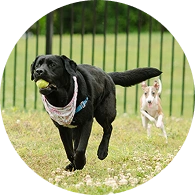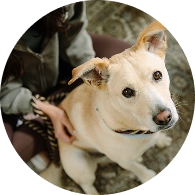Nom Nom Blog
What’s your dog’s ideal weight?
Maintaining your dog’s weight isn’t just about looks—it’s essential for their overall health and longevity.
“Studies in dogs have shown that being overweight contributes to the severity of many health problems, such as osteoarthritis, and can even shorten life expectancy,” says board-certified veterinary nutritionist Sally Perea, DVM, MS, DACVIM.
On the other hand, being underweight could signal underlying health problems like malnutrition or illness. But how do you know what your dog’s ideal weight is, and how can you help them stay in that range? Let’s break it down.
How to Determine Your Dog’s Ideal Weight
According to Dr. Perea, one way to determine your dog’s ideal body weight is to evaluate their body condition score, using the following assessments.
-
Ribs: Easily felt but not visible.
-
Waistline: Visible when viewed from above.
-
Tummy Tuck: Abdomen should slope upwards from the ribcage to the hind legs.
“An evaluation and consultation with your veterinarian is the best place to start, as they can help you to assess where your dog falls on the BCS scale, and help you to calculate your dog’s ideal body weight,” Perea says.
As a rule, for each BCS score above ideal (BCS 5), your dog is approximately 10% overweight. For example, if your dog is a BCS 7 (on the 9-point scale), this would be approximately 20% above ideal.*
*Laflamme, D
Development and validation of a body condition score system for dogs
Canine Pract. 1997; 22:10-15
Breed-Specific Guidelines
Many breeds have a general weight range based on size and build. For example:
-
Labrador Retrievers: 55–80 lbs
-
Dachshunds: 16–32 lbs
-
Chihuahua: 3–6 lbs
Check with your vet or use breed-specific resources to find the typical range for your pup. Just keep in mind that individual factors like age, activity level and body composition mean your dog may fall slightly outside the average range.
Average Adult Weights for Common Large Breed Dogs
| Breed | Male | Female |
|---|---|---|
| Labrador Retriever | 75 lbs | 65 lbs |
| Golden Retriever | 70 lbs | 60 lbs |
| Doberman Pinscher | 85 lbs | 75 lbs |
| Rottweiler | 115 lbs | 90 lbs |
| Poodle (Standard) | 65 lbs | 45 lbs |
| German Shepherd | 75 lbs | 60 lbs |
| Collie | 70 lbs | 60 lbs |
| Great Dane | 160 lbs | 130 lbs |
| Mastiff | 200 lbs | 150 lbs |
| German Shorthaired Pointer | 65 lbs | 55 lbs |
Average Adult Weights for Common Small Breed Dogs
| Breed | Weight |
|---|---|
| Chihuahua | 5 lbs |
| Shih Tzu | 12 lbs |
| Miniature Poodle | 12 lbs |
| Pug | 16 lbs |
| Dachshund / Mini Dachshund | 10 lbs / 10 lbs |
| Pomeranian | 5 lbs |
| Boston Terrier | 18 lbs |
| Maltese | 6 lbs |
| Yorkshire Terrier | 7 lbs |
| French Bulldog | 22 lbs |
Weigh-Ins
Regular weigh-ins at home or the vet can help you track your dog’s weight. Use a pet scale or weigh yourself holding your dog and subtract your weight.
Tips for Maintaining Your Dog’s Ideal Weight
The best way to maintain your dog’s weight is to monitor and adjust the amount fed as needed.
“Every dog is unique in their energy requirements, so feeding guidelines should always be a starting point that is monitored and adjusted as needed,” Dr. Perea says. “Whenever you start a new diet or feeding plan, it can be helpful to weigh your dog at the start and then again after two weeks to see if any adjustments in the amount fed are needed.”
Feed Your Dog the Right Amount
Use portion guidelines on your dog food packaging as a starting point. Vet-developed, gently cooked subscription diets like Nom Nom take out the guesswork, as they’re portioned and packaged for your dog’s unique needs.
Portions should be adjusted based on activity level and age. Puppies and highly active breeds may need more calories, while senior or less active dogs require fewer.
Choose High-Quality Nutrition for Your Dog
Opt for nutritionally balanced dog food tailored to your dog’s size, age and health needs. Avoid feeding too many treats or table scraps, which can pack on extra calories.
Incorporate Regular Exercise in Your Dog's Routine
Daily walks, playtime, or activities like swimming can help burn calories. Adjust the intensity based on your dog’s breed and energy level.
Limit Your Dog's Treats and Snacks
Treats should make up no more than 10% of your dog’s daily caloric intake. Choose low-calorie options or use small pieces of their regular kibble as a reward.
Monitor Your Dog's Weight for Changes
Sudden weight gain or loss can signal an underlying health issue, such as hypothyroidism or gastrointestinal problems. If you notice a change, consult your vet immediately.
______________________________________________________________________________________________________
Common Challenges Managing Your Dog's Weight
Multiple Dogs in the Home
If you have more than one dog, ensure each is eating their portioned meals. Separate feeding areas can prevent food sharing and your dogs from over- or under-eating.
Begging Behavior
Begging doesn’t always mean hunger—it could be boredom or habit. Redirect your dog’s attention with a toy or activity instead of a snack.
Age-Related Weight Changes
As dogs age, their metabolism slows. Work with your vet to adjust their diet and exercise routine accordingly.
__________________________________________________________________________________________________
How Nom Nom Supports a Healthy Weight in Dogs
Nom Nom’s vet-developed recipes are formulated for the complete and balanced nutrition that pups need, and customized to the individual your dog is. Parents supply details like their dog’s age, weight, activity level and more, and Nom Nom recommends a diet that’s portioned and packaged for their unique nutritional and caloric needs to keep them at a healthy weight, not to mention personal tastes.
Any changes, such as weight or activity level, can be easily made to your account in order to ensure your pup has a diet that supports their health and maintains their ideal weight. Give Nom Nom a try today!









